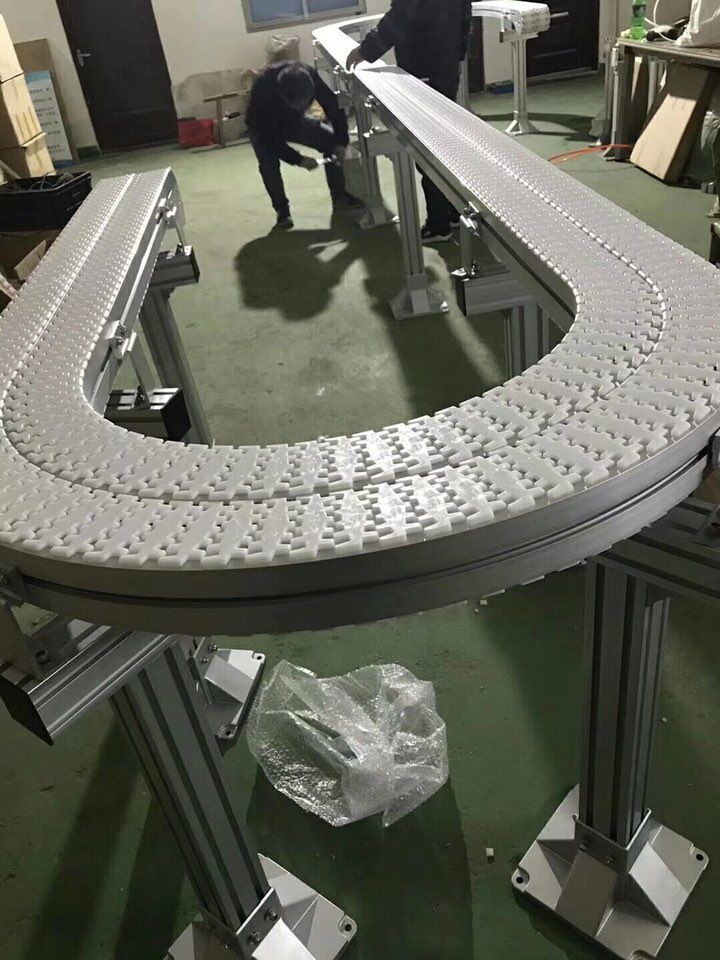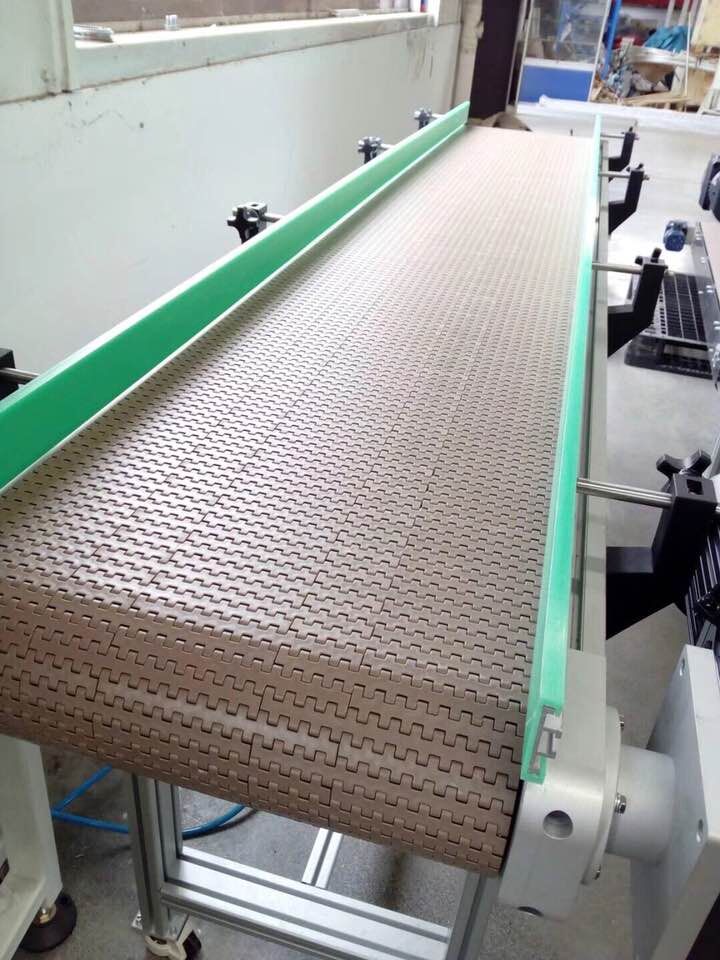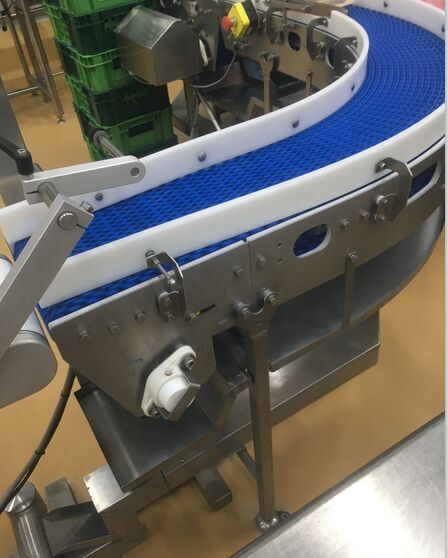Conveyors are a part of everyday life. They are seen at the grocery store, in the gym, at the redemption center, and in the airport. Conveyors are also an integral part of manufacturing — used during all stages of assembly, packaging, and distribution.
The earliest conveyors date to the 18th century. They were constructed of wood with leather belts to transport goods and were driven via hand-cranks and series of pulleys. As new inventions were introduced, they were adapted to conveyors. The dawn of the 20th century brought with it a major development — the steel-belted conveyor. Steel-belted conveyors first grew in use for carrying bulk materials such as gravel and sand; soon they were adapted for use in the mining industry.
American slaughterhouses and Henry Ford paved the road for conveyors in modern manufacturing processes. World War II and its depletion of natural resources such as cotton and rubber forced inventors and industrialists to look for alternatives, and some of these materials (including synthetic rubber and polyurethane) ushered in a new era of conveyor technology.
Conveyors, of which there are many types, are primarily defined by the conveying medium — as belt conveyors, chain conveyors, and roller conveyors, for example. Conveyors referred to as belt conveyors more often than not are synthetic belt conveyors that use the synthetic fabric belting materials pioneered during WWII. This type of conveyor belt is seen most often at grocery-store checkout stations. It’s a continuous loop of fabric that delivers continuous motion through use of friction between the bottom belt surface and a motor-driven conveyor pulley.
In 1970, Intralox founder J. M. Lapeyre pioneered plastic modular belting. These belts are pieces of plastic that join together in an interlaying brick fashion. Conveyors that use such belting are called plastic modular belt conveyors or (by some manufacturers) modular plastic-belt conveyors.
While plastic modular belting has transformed the conveyor industry and various manufacturing processes, understanding the differences between synthetic fabric belts and plastic modular belts can help in planning and determining the suitable type of conveyor for use in specific applications.
Design features and conveyor applications for fabric belts
Synthetic fabric belts are the belts most commonly seen in everyday situations at airports, retail stores, fitness centers, and in and around agricultural (farm) settings. Versatility is one of their main benefits. Synthetic belts also excel in industries and applications such as printing and tapes where plastic modular belts cannot be used.
Conveyors with a modular design give engineers more flexibility.
Synthetic belts are monofilament in design and fabrication. This results in two distinct and important advantages — high tensile strength and an excellent width-to-strength ratio. Synthetic belts are lightweight but very strong and flexible. This flexibility lets synthetic belts run on very small pulleys and even knife edges. With diameters down to 3 mm in some cases, knife edges are ultra-thin conveyor ends defined by small-diameter rollers or (more commonly) fixed bars tapered to make a rounded point. Such knife edges facilitate the transfer of small parts on and off the conveyor surface.
Some advanced modular plastic-belt variations work well with small pulleys, but they still cannot compete with traditional belts on knife edges. Traditional belts combine flexibility with availability in low overall thicknesses (often less than 1 mm and almost always less than 2 mm) so are suitable for transferring small and delicate parts between conveyors as well. This is because the thickness of a conveyor’s belting adds to the overall radius of the pulley transferring parts — and the smaller this dimension, the smaller the part that can be transferred.
While the size of the part to be conveyed is one consideration, another important factor in determining what type of belt to use is the speed of the conveyor. Synthetic fabric belts can handle a greater speed range than plastic modular belts. At high speeds, plastic modular belts can become loud, making them undesirable in locations where excessive noise is an issue for workers or processes.
However, synthetic fabric belts are not without their design and implementation challenges. Where fabric-belt limitations leave applications unserved is where plastic modular belts excel. Conveyors that use fabric belts are friction drive systems, meaning the friction between the underside of the belt and the drive pulley or drum causes the belt to move. If conveyor designers and fabricators fail to account for the material and finish of the pulley in relationship to the load, speed, and other environmental concerns, then the conveyor will not operate as intended.
Furthermore, designers must adhere to design specifications for the drive pulley as outlined by the belt manufacturer. While this seems simple in principle, designers often implement pointed crown pulleys instead of trapezoidal crown pulleys. This results in conveyors that don’t run … or that run but with belting that doesn’t track or stay on the conveyor frame.
In fact, a major downside of fabric belts and their associated conveyors concerns tracking — the ability of a belt to stay centered on the conveyor. Proper conveyor design and installation are necessary to get optimal belt tracking. There are some schools of thought that this hurdle can be overcome by adding a v-guide to the underside of the belt (or less often to the topside outside edges). This v-guide is a small trapezoidal polymer rope that travels in a channel or notch on the conveyor frame. In theory, as long as the v-guide remains in the notch, then the belt remains tracked. This method of belt tracking is considered suboptimal by most belt manufacturers, as the v-guide is simply another possible point of failure and doesn’t guarantee that the belt will remain tracked.
Plastic modular belts: Design features and operation in conveying
Tracking ability is one of the biggest selling features of plastic modular belt. Unlike fabric belts, which rely on friction for the means of driving, plastic modular belts are based on positive drive. This means that a series of sprockets engages with the underside of the belt to propel it forward. This positive engagement — the fitting of sprocket teeth into specific pockets on the underside of the belt — is what ensures belt tracking.

Sprockets for plastic modular belt mount on the drive shaft of the conveyor and engage with the underside of the belt to form a positive drive system.
As with synthetic belts, it is important for the conveyor designer to follow belt-manufacturer instructions for drive sprocket design. Using the correct number of sprockets and placement will ensure optimal belt and conveyor performance.
Furthermore, the concept of a positive drive provides for a friendlier and more flexible design. Plastic modular belt conveyors are low-tension systems, especially compared with synthetic belt (which requires proper tension for the friction drive to work). Lower tension allows use of fewer pulleys. Plastic modular belts also impart greater design freedom to let engineers dimension conveyors with more latitude. To illustrate, synthetic belt conveyors typically require a length-to-width ratio of 2:1 to track properly. In contrast, plastic modular belts allow conveyor designs that are wider than they are long while still maintaining belt tracking.
Plastic modular belts excel in applications where a conveyor must travel around corners. While corners can be negotiated using synthetic belts, these conveyors are highly customized and often cost-prohibitive. Plastic modular belt conveyors can travel straight, go around corners, straight again, incline and decline all using one belt and one motor — one conveyor.
Shown here is a curved conveyor from mk North America. Plastic modular belt conveyors can easily be designed with curves provided that the correct type of belt is used.
Plastic modular belts and their conveyors are often considered too expensive compared with other conveyor types because of the way which the belts are fabricated. While the small plastic blocks or modules that are used to construct such belts are relatively inexpensive, it requires manpower to assemble them. It is this human effort needed to construct them that drives up their cost. All belt manufacturers have assemblers who piece together the belt bricks and join the rows using rods. No manufacturer has yet found an effective way to automate the assembly of these belts.
Choosing between various conveyor-belt options
With all of these different features, benefits, drawbacks, and design considerations, it can feel like a daunting task to pick the right belt type and the correct conveyor type for an application. Reviewing design options with a belting representative or sales engineer from a conveyor company is a good starting place. Both will help account for various factors that ultimately determine the best selection — or if a different (non-belted) conveyor style is necessary. Working directly with a conveyor supplier can and should help design engineers consider various belting types and even different belt companies.
Click to enlarge.
When working with either type of company, the engineer must ultimately determine the best fit for the application. Both belting types come in a variety of materials, finishes, and styles. However, plastic modular belts have limitations because they are designed around pitches. This means that once a pitch is selected and the conveyor is designed around it, the conveyor can only use belts of that pitch. To further complicate matters, many belt manufacturers make the same pitch belt but in different series. Because of innate characteristics of a design (such as belt thickness or sprocket design and style) a conveyor may be able to accept only belts in that series. Synthetic belts are not limited in this aspect. There are many more options from which an engineer can choose when making post-install changes. For this reason, the lifecycle of the product being conveyed is another important parameter.
Other product aspects such as temperature and material also can affect the selection. Generally speaking, synthetic fabric belts have a wider range of accepted exposure temperatures. The choice of belt option also can depend on the specific-purpose equipment with which the belt may be used. These specific purposes include conveyors for X-ray machines, static-sensitive areas, cleanrooms, and food manufacturing.
Both belt types are available with top slide flights or cleats. These paddle-like attachments are designed to aid in conveying product up inclines or provide for crucial pocketing or spacing on assembly lines. With synthetic belts the cleats are typically welded ultrasonically to the belt. These cleats are seen as permanent, so if the spacing needs to change, a new belt is needed. Likewise, if one of the cleats breaks it cannot be simply glued on; here too, a new belt would be needed. Plastic modular belt cleats are specialized modules with the belt brick and cleat injection molded into one solid piece. This allows for easier changing of cleat height and spacing. If one gets broken, only the associated module needs replacing. Both styles come in a variety of heights and side profiles (including straight up and scoop style).
FDA-approved belts in both synthetic and plastic modular types are available for food manufacturing facilities. There has been a huge shift recently in the food industry toward the primary use of plastic modular belts. The driving factor in this shift is the ability to easily sanitize plastic modular belts. Because of the more intricate and interlocking belt design, one might assume just the opposite. However, the ease in taking plastic modular belts apart or off a conveyor makes it easy to clean them and to clean the conveyor.

Plastic modular belts are suitable for conveying food products such as pizza due to their ease of cleaning.
With fabric belts, a belt-lifting device is needed on the conveyor to assist sanitization. This device lifts the belt off the conveyor so that the conveyor under it (as well as the underside of the belt) can be cleaned. But this process is cumbersome and nearly impossible with long or wide conveyors. That’s why plastic modular belting is increasingly common in such applications. In the baking industry as well as meat, poultry, and seafood processing, plastic modular has become the standard. Even so, fabric belts are still widely used in the confectionery industry (because of product-release capabilities) and in pharmaceuticals (due to the size of the various medications and pills processed).
This is a food-grade fabric belt carrying strawberries.
Fabric belts also remain the suitable choice in many consumer-oriented markets such as security systems in courthouses and airports, bottle and can-redemption machines, grocery stores, and treadmills. Because these conveyor types are commonplace in public venues, they are what most people think of when they hear the word conveyor. However, plastic modular belts are making inroads into the carwash industry, which was once dominated by chain conveyors.
High-speed applications as found in mail and logistic industries still heavily rely on synthetic belts because plastic modular belts cannot handle the speeds needed.
Choosing the right belting style for a given application might seem like a matter of personal preference, but the two belt styles that predominate in industry settings today have distinct advantages and disadvantages that may make them right for some applications but not others. Plant and design engineers owe it to themselves to discuss the relative merits and demerits with a knowledgeable conveyor-company representative or belting manufacturer and then choose wisely.


